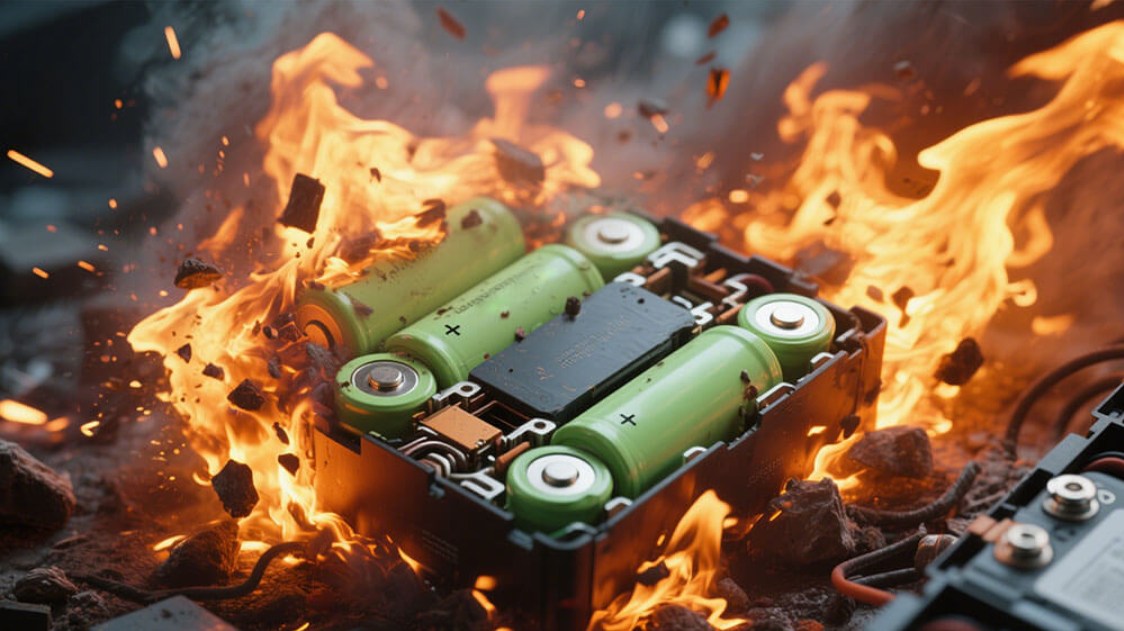
Thermal runaway in lithium-ion batteries occurs when excessive heat triggers a self-sustaining chain reaction, resulting in rapid temperature spikes and potential explosions.This phenomenon poses significant fire risks, particularly in urban environments where devices like e-bikes are widespread. With over 25,000 incidents reported globally in five years, understanding prevention methods is critical for public safety.
-Thermal runaway in lithium-ion batteries can lead to fires or explosions. Recognizing its progression helps enable early intervention.
-Proper charging practices—using compatible chargers, avoiding overcharging, and maintaining safe temperatures—are essential for risk reduction.
-Advanced battery management systems (BMS) enhance safety by monitoring heat and preemptively addressing conditions that may trigger thermal runaway.
1.1 Definition and Stages
Thermal runaway refers to a self-sustaining exothermic reaction in lithium-ion batteries, driven by uncontrolled heat generation. The process unfolds in four distinct stages:
Stage | Initiating Temperature | Description |
1 | ~80℃ | Solid Electrolyte Interphase (SEI) decomposes, exposing electrodes to electrolytes. |
2 | ~100℃ | Electrolyte decomposition releases flammable gases, accelerating temperature rise. |
3 | ~130℃ | Separator melts, causing internal short circuits via electrode contact. |
4 | ~150℃ | Cathode decomposition releases oxygen and gases, escalating explosion risks. |
Early detection during these stages is vital to prevent catastrophic outcomes.
1.2 Safety Concerns
Thermal runaway poses severe safety threats due to its uncontrollable nature. Hazardous gases generated during the process can ignite, leading to structural damage and life-threatening scenarios. Devices such as electric vehicles (EVs) and power tools are particularly vulnerable.
-Incident reports indicate a 28% increase in thermal runaway cases between 2019 and 2023, averaging two incidents per week in the TRIP database.
-While rare in aviation, stringent safety protocols remain crucial for all applications.
1.3 Real-World Incidents
Notable examples underscore the dangers:
-2016 Smartphone Recall: Millions of devices were recalled after multiple units ignited due to thermal runaway.
-EV Battery Fires: Thermal runaway in electric vehicles has caused property damage and injuries.
-Urban E-Bike Fires: Over 25,000 incidents in five years highlight growing urban safety challenges.
2.1 Common Triggers
-Overcharging: Exceeding voltage limits generates excess heat.
-Physical Damage: Punctures or crushing induce internal short circuits.
-Manufacturing Defects: Separator flaws or poor cell design.
-Environmental Stress: Exposure to extreme temperatures or humidity.
"A 20% temperature increase in lithium-ion batteries accelerates unwanted reactions, creating a feedback loop of heat generation—known as thermal runaway."
—Clemson News, 2023
2.2 Critical Conditions
Thermal runaway begins when heat generation surpasses dissipation capacity. UL Research Institutes observed temperature surges exceeding 20℃ per minute, reaching over 300℃. Key triggers include:
-Internal short circuits from dendrite growth or separator failure.
-External factors like rapid charging (causing dendrite formation) or high ambient temperatures.
2.3 Internal vs. External Factors
Factor Type | Examples |
Mechanical Abuse | Physical damage (e.g., punctures, drops). |
Electrical Abuse | Overcharging, rapid charging. |
Thermal Abuse | Exposure to high temperatures. |
Addressing these factors requires improved designs, proper usage, and robust thermal management.
3.1 Design and Material Innovations
-Enhanced Cooling: Battery modules with bottom injection holes optimize adhesive application to reduce cell damage.
-Safety Systems: Compartments with auto-opening covers at critical temperatures enable rapid cooling.
-Flame Retardants: Thermal fluids infused with retardants suppress fire risks during punctures.
3.2 Best Practices for Usage
-Charging: Use manufacturer-approved chargers; avoid rates exceeding 1C.
-Temperature: Charge between 0℃–45℃; store in cool, dry environments.
-Charge Levels: Maintain 20%–80% capacity to reduce stress.
3.3 Role of Battery Management Systems (BMS)
A BMS ensures cell balance and monitors:
-Real-time temperature fluctuations.
-Hotspots from uneven resistance.
-Stress conditions to preempt failures.
3.4 Thermal Management Solutions
-Phase Change Materials (PCM): Absorb heat via latent properties.
-Fire Suppression: Systems like Novec 1230 or water mist cool batteries and extinguish flames.
4.1 Early Warning Signs
-Sudden temperature/voltage drops.
-Gas emissions (e.g., hydrogen, CO₂).
-Visible venting, smoke, or flames.
4.2 Immediate Actions
-Cooling: Submerge batteries in non-flammable liquids.
-Suppression: Use Halon extinguishers (note: they halt flames but not reactions).
-Safety Zones: Isolate the area to protect responders.
4.3 Effective Suppression Methods
Method | Description |
Novec 1230/FM-200 | Specialized agents for lithium-ion fires. |
Potassium Bicarbonate | Dry chemical for flame suppression. |
Water Mist | Cools without thermal shock. |
Preventing thermal runaway requires adherence to safety protocols, regular inspections, and advanced technologies. Innovations like reinforced battery layers have reduced explosion risks by 53%. By prioritizing proper handling and leveraging modern solutions, lithium-ion batteries can remain safe and reliable for everyday use.